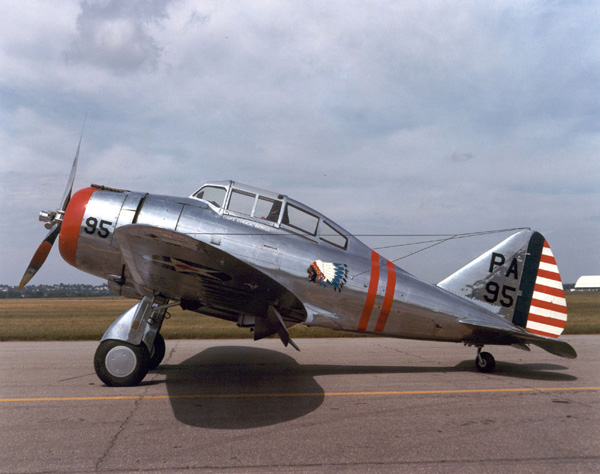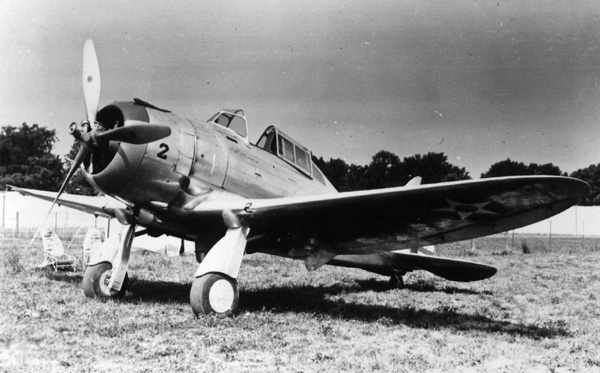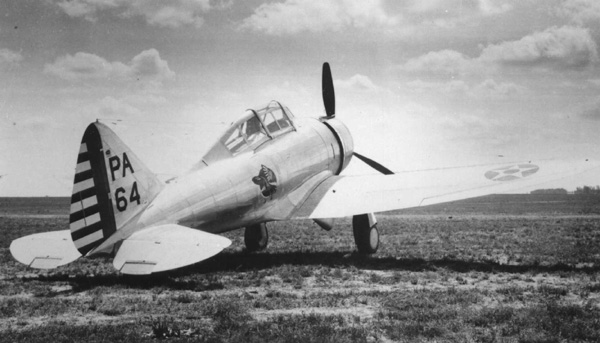
|
 |
Seversky P-35 |
 |
 |
 |
 |
 |
|---|---|---|---|---|---|---|---|
 |
 |
 |
 |
 |
|||
 |
||
|
Among the significant fighter designs appearing in the 1930s, the Seversky P-35 is worth mentioning. Despite its career at being somewhat undistinguished, it paved the way for future aircraft that would be sorely needed for World War II. It was a sleek and sophisticated design that would ultimately lead to the development of the celebrated Republic P-47 Thunderbolt. |
| The P-35 was a collaboration between Alexander P. de Seversky and Alexander Kartveli of The Seversky Aircraft Corporation, which started out as a private venture in 1931.1 (Alexander Kartveli would later become the chief designer of the Republic P-47.)The P-35 was derived from the Seversky SEV-3, which had set a record for piston-engined amphibious aircraft reaching 230 mph (370 km/h).2 The SEV-3 was conceived as basic design that would allow for the installation of various engines to be used in roles such as a basic trainer, two-seat escort fighter, naval fighter, from which several racing versions were built. The original amphibious SEV-3 was constructed in a rented hangar from The Edo Aircraft Corporation in College Point, NY. Edo specialized in the construction of aircraft floats. |
|
The country of Columbia ordered six amphibious reconnaissance versions of the SEV-3, while the US Army Air Corps (USAAC) ordered 30 dual controlled, twin-seat, fixed-gear versions and designated it the BT-8.

In 1935, design competitions were being held by the USAAC for the purpose of replacing the Boeing P-26 Peashooter. The fixed-gear two-seat SEV-2XD fighter design was originally submitted by Seversky, but was switched to the single-seat SEV-1XP after eyeing the Curtiss Model 75 and Northrop 3A, both of which had retractable landing gear. The switch by Seversky was allowed since it was badly damaged, after crashing into the sea (perhaps deliberately), on the way to the Wright Field competition on June 18,1935.3 This drew protests from Curtiss, but the fly-off was postponed until April 1936.4 The delay allowed Seversky to modify its entry with a different tail-plane and a Pratt & Whitney R-1830 Twin Wasp engine,5 designating it the SEV-7, while Vought submitted a rebuild of the Northrop A3, the V-141; Consolidated submitted the P-30 and Curtiss submitted the Model 75, with a new Wright CycloneXR-1820-39 engine—which incidentally was the same engine Seversky had abandoned.6 While the SEV-7 did not reach its estimated speed of 300 mph, it was awarded a contract for seventy-seven production models with the USAAC designation the P-35. The construction of the P-35 was of a all-metal low-wing cantilever monoplane with fabric covered flight controls. It had an enclosed cockpit and the wings were elliptical, similar to the Supermarine Spitfire, with ailerons and flaps on the trailing edge.7 The main landing gear retracted aft and was partially faired, while the tail wheel was fully enclosed. The partially faired landing gear of the P-35 was a major fault in an era where flush-folding landing gear was becoming common-place on new fighter designs such as the Hawker Hurricane, Messerschmitt Bf 109, Curtiss Model 75 and the Dewoitine D.520. In comparison the P-35 appeared awkward and outdated. The engine had a wide cowling, which enclosed one 0.50 caliber machine gun and one 0.30 caliber machine gun. Armament was completely inadequate when compared to the contemporary European fighters of the time. It also lacked armor protection for the pilot and self-sealing fuel tanks, which resulted in an aircraft that was very vulnerable against enemy fighters. Delivery of P-35s took place between July 1937 and August 1938, but production delays prompted the USAAC to purchase 210 Curtiss P-36 Hawks, which had come in second in the 1936 competition as the Model 75. The final P-35 on this contract was completed in 1938, with a revised wing and a supercharged 1,200 hp (895 kW) Twin Wasp engine. This was the 77th aircraft produced and had a modified landing gear. This aircraft became the single Seversky XP-41 prototype and was developed in parallel with the P-43 Lancer. Along with the production delays, Seversky developed a two-seat export version of the fighter, known as the 2PA-L, powered by a single-row Wright Cyclone engine instead of the Twin Wasp. Twenty aircraft were sold secretly to Japan and given the JNAF designation A8VI. Japan was already causing problems for the United States and the US Government pressured the USAAC to reduce Seversky's order. Two 2PA-Ls were sold to the USSR late in 1937, together with a manufacturing license, although it is not known if any aircraft were actually built in the Soviet Union.8

A single seat export version known as the EP-1 was also produced, but with the larger 1,050 hp (783 kW) Pratt & Whitney R-1830-45 Twin Wasp engine, along with heavier armament of two 0.50 caliber machine guns in the nose, and two 0.30 caliber machine guns in the wing roots. Sweden ordered one hundred and twenty of these, identified for export as EP-106s and designated J9 in service with the Flygvapnet. Sixty aircraft had been delivered when, in mid-1940, an embargo was placed upon aircraft overseas sales, except for England, and in October 1940 the remaining sixty EP-106s were requisitioned for the USAAC and designated them as P-35As.9 In 1937, one P-35 was converted by the Naval Aircraft Factory as the XFN-1. It competed for a US Navy contract against the Grumman XF4F-2 and the Brewster XF2A-1, but Brewster was declared the winner in the competition and no other Seversky naval versions were produced.10 While the name of Seversky was associated with record setting aircraft of the 1930s Bendix and Thompson flying races by; Frank Fuller who averaged 258 mph (415 km/h) from Burbank, California to Cleveland, Ohio; Jacqueline Cochrane who reached 304.7 mph (490 km/h); and Seversky himself who set the amphibious speed record of 230 mph (370 km/h) in 1935,11 the realities of war would provide no such glory. As soon as the P-35 came under fire, lacking armor protection and self-sealing tanks, the aircraft stood little chance against enemy fighters. By December 12, 1941, of the forty aircraft that had been sent to the Philippines, only eight were airworthy, after either being shot down or destroyed on the ground. While it is a beautiful aircraft to look at, regretfully it was said that it was not much more than that. The P-35 left much to be desired as a fighter airplane, but the saving grace was that it led to the development of the Republic XP-41 and Republic P-43 Lancer. When the order for the P-35 was placed in 1936 by the Material Division of the USAAC, they stipulated that the last series of aircraft should have the 1,200 hp (895 kW) Pratt & Whitney R-1830-19 two stage supercharged engine, instead of the 850 hp (634 kW) version. This experimental version was designated the XP-41 and simultaneously Seversky started a company funded project known as the AP-4.12 The AP-4 became the production model for the P-43 Lancer and forerunner of the Republic P-47 Thunderbolt, which became one of the most outstanding fighters of WWII. |
| Seversky/ Republic P-35A |
Specifications: | |
|---|---|---|
| Dimensions: | ||
| P-35 | P-35A | |
| Wing span: | 36 ft (11.00 m) | 36 ft (11.00 m) |
| Length: | 25 ft 2 in (7.67 m) | 26 ft 10 in (8.17 m) |
| Height: | 9 ft 1 in. (2.76 m) | 9 ft 9 in. (2.97 m) |
| Wing Area: | 220 ft.² (20.43 m²) | 220 ft.² (20.43 m²) |
| Weights: | ||
| Empty: | 4,315 lb. (1,975 kg) | 4,575 lb. (2,075 kg) |
| Gross: | 5,595 lb (2,540 kg) | 6,118 lb (2,775 kg) |
| Max T/O: | 6,295 lb (2,855 kg) | 6,723 lb (3,050 kg) |
| Performance: | ||
| Cruise Speed: | 260 mph (418 km/h) | 260 mph (418 km/h) |
| Max Speed: |
282 mph (454 km/h) @ 10,000 ft (3,048 m) |
290 mph (467 km/h) @ 12,000 ft (3,658 m) |
| Climb Rate: | 15,000 ft/ 6.9 min (4,572/6'54") | 1,920 ft./min (585 m/min) |
| Service Ceiling: | 30,600 ft. (9,327 m) | 31,400 ft. (9,571 m) |
| Absolute Ceiling: | 31,750 ft. (9,677 m) | 32,300 ft. (9,845 m) |
| Normal Range: | 1,150 miles (1,851 km) | 600 miles (966 km) |
| Max Range: | 1,150 miles (1,851 km) | 950 miles (1,529 km) |
| Powerplant: | |
|---|---|
| P-35 | P-35A |
|
Pratt & Whitney 850 hp (634 kW) R-1830-9 Twin Wasp radial engine. |
Pratt & Whitney 1,050 hp (783 kW) R-1830-45 Twin Wasp radial engine. |
| Armament: | |
|
One 0.30 in machine gun; one 0.50 in machine gun; up to 300 lb (136 kg) of bombs |
Two 0.30 in machine guns; two 0.50 in machine guns; up to 350 lb (160 kg) of bombs |
| Endnotes: |
|---|
|
1. Howard Mongos, ed. The Aircraft Year Book for 1936. (New York: Aeronautical Chamber of Commerce of America, Inc., 1936.) 440. 2. Enzo Angelucci and Peter M Bowers. The American Fighter. (Mila, Italy; Haynes Publishing Group., 1987. 384.) 3. David Mondey. American Aircraft of World War II. (New York, Smithmark Publishers, 1996.) 213. 4. Peter M. Bowers. "The Curtiss Model 75" Aircraft In Profile, Volume 4. (Surrey, England; Profile Publications Ltd., 1970.) 95. 5. Ibid. 6. Ibid. 7. David Mondey. 213. 8. Kenneth Munson. Fighters Between the Wars, 1919-39. (New York, The Macmillan Company, 1960.) 156. 9. Enzo Angelucci and Peter M Bowers. 386. 10. Frank L. Green. "The Grumman F4F-3 Wildcat." Aircraft in Profile, Volume 4.. (New York: Doubleday & Company, Inc., 1968.) 5. 11. Roger A. Freeman. Thunderbolt. (Osceola, Wisconsin: Motorbooks International, 1992.) 13. 12. Enzo Angelucci and Peter M Bowers. 388. |
| Other Sources: |
|
Howard Mingos, ed. The Aircraft Year Book for 1936. New York: Aeronautical Chamber of Commerce of America, Inc., 1936. 277. Howard Mingos, ed. The Aircraft Year Book for 1937. New York: Aeronautical Chamber of Commerce of America, Inc., 1937. 317-319. |
©Larry Dwyer. The Aviation History Online Museum.
All rights reserved.
Created June 8, 2007. Updated April 20, 2014.